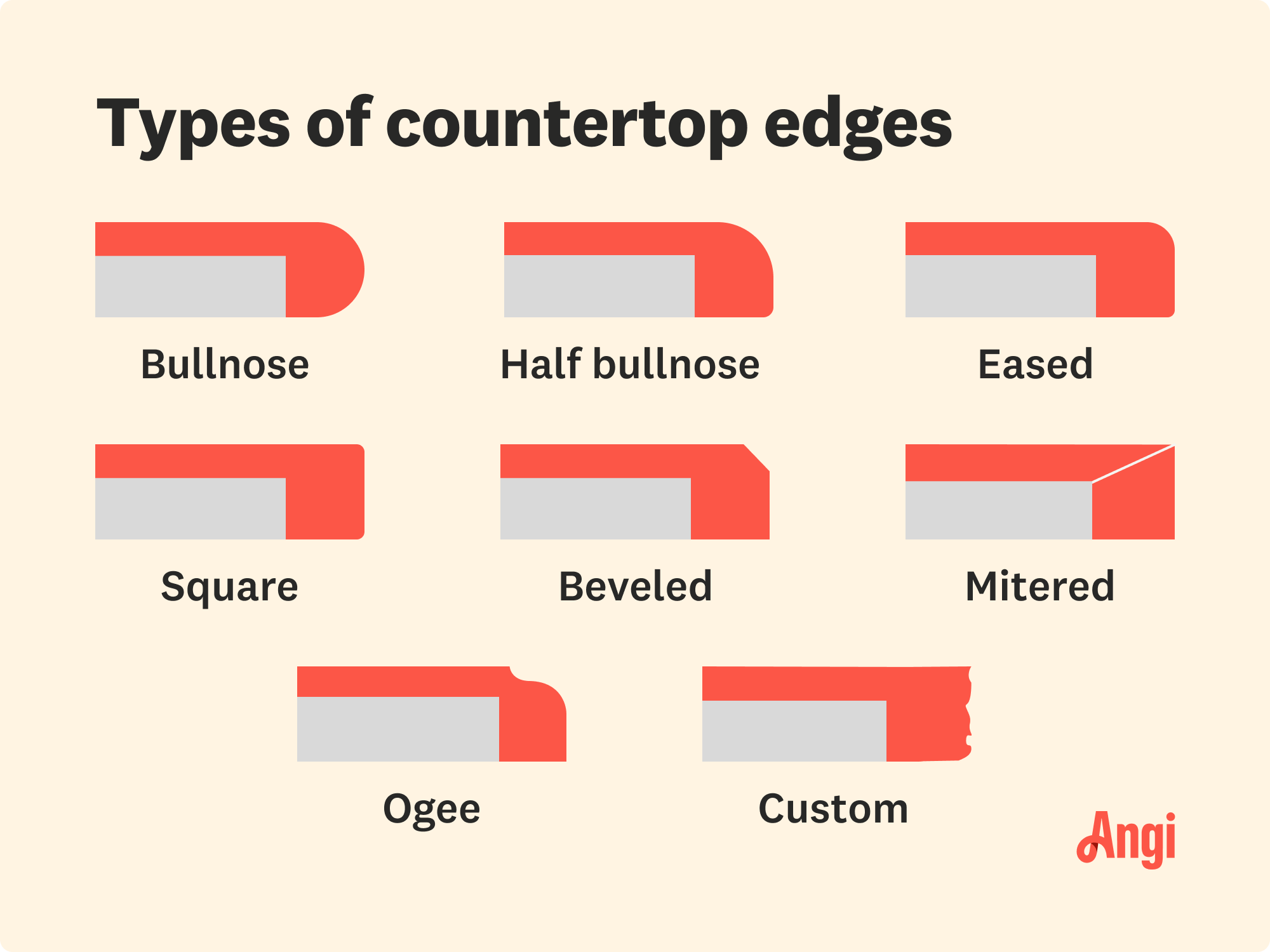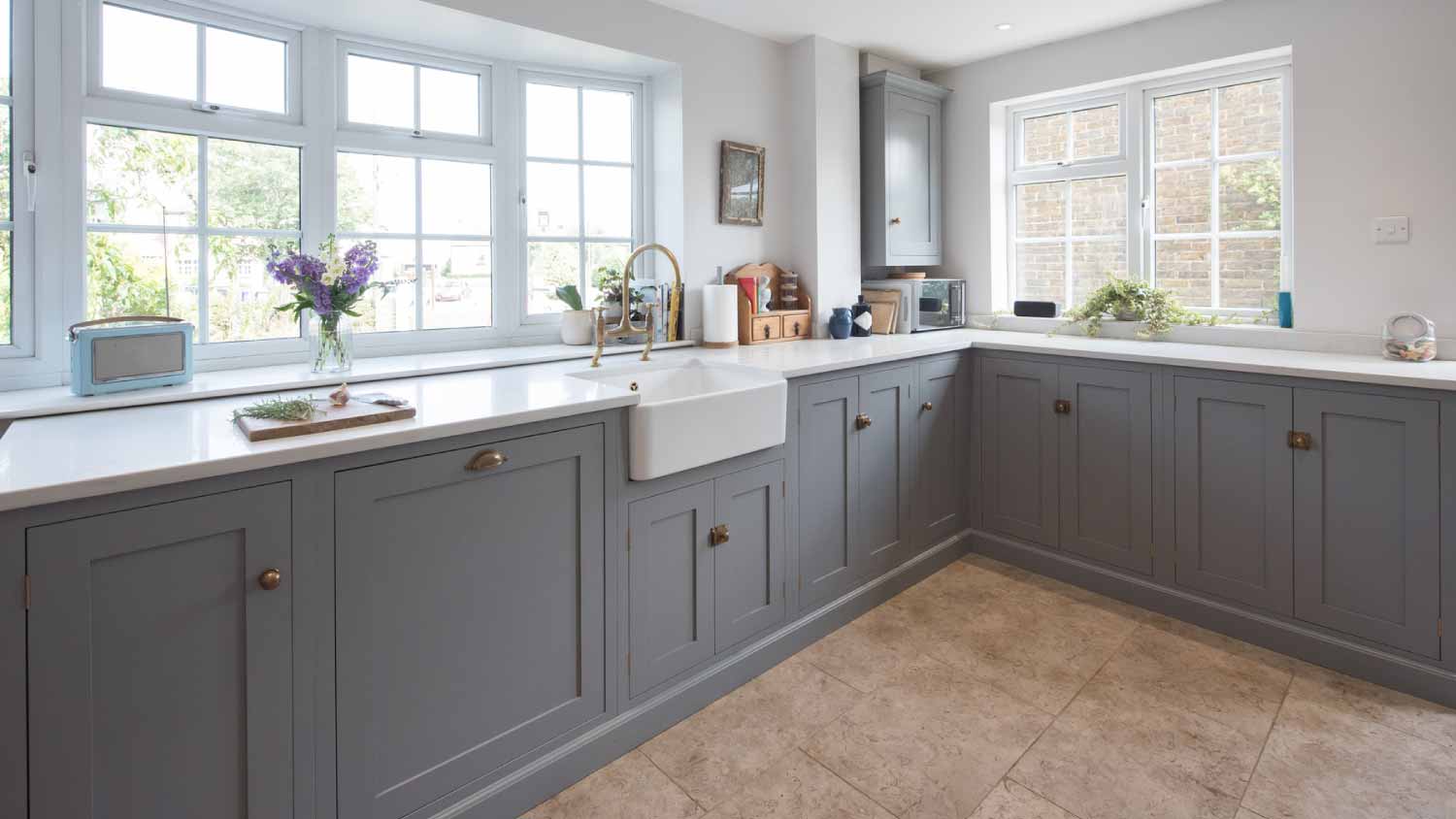
Explore how much concrete countertops cost to install based on factors like their size, thickness, location, finish, and labor rates.
Add a bit of luxury to your kitchen with this modern edge option


Mitered edges offer a thick, luxurious look to a kitchen or bathroom.
This edge profile complements both traditional and modern styles.
Almost any countertop material can have a mitered edge.
The cost of a mitered edge is usually an upcharge of $15–$45 per linear foot.
Each element of your kitchen or bathroom plays a role in its atmosphere and appearance. A mitered edge countertop is a bold design choice that offers a beautiful, thicker countertop finish without the cost of cutting a slab of stone, quartz, marble, or other material. Learn all about a mitered edge, its pros and cons, costs, and if it’s right for your countertop.

A mitered edge is a seamless 90-degree edge that joins the top countertop surface with a second, smaller piece of countertop. The two pieces are cut at 45-degree angles and fused together for a seamless look. A mitered edge profile offers the appearance of a thicker slab of stone or granite or merges with a waterfall panel.
A mitered edge profile is a specialty edge that you can request from your local countertop installer and is distinct from a square edge. You can choose an apron size—the apron is the piece that hangs down vertically—between two and six cm. The thicker the apron, the greater the impression it leaves. You can also choose an eased mitered edge, which offers a rounded look where the two pieces join.
When creating a mitered edge, the pattern must match up precisely between the two pieces of countertop material. The slabs should be precisely cut and then mounted together so no joints are visible. A mitered edge takes skill, experience, and care—definitely one that's best left to a countertop expert.
Cutting thicker slabs of granite, stone, or marble is more costly, but making a mitered edge profile is a great way to achieve a wider look with any additional countertop material.
Choosing the type of countertop edge for your kitchen or bathroom can greatly impact how the room looks. Adding an apron with a mitered edge makes the countertop look wider and more luxurious. A mitered edge also allows for a waterfall countertop that runs vertically from the countertop to the floor.
A square edge, on the other hand, is less expensive than a mitered edge, but it doesn’t capture the same luxury. Square edges are standard and result in a standard look.
A mitered edge offers a contemporary finish but isn’t right for every space. Here are the main benefits and drawbacks of a mitered edge countertop:
| Pros | Cons |
|---|---|
| Elegant finish | Expensive |
| Easy to clean | Requires a pro |
| Modern | Heavy |
Adds an elegant finish to a kitchen or bathroom
Creates a thicker appearance or leads into a waterfall edge
Costs less than a new slab of granite, stone, marble, or other material
Gives the room a focal point or statement
Pairs well with modern and traditional designs
Easy to clean and maintain countertop
More expensive than a standard edge
Requires an experienced countertop installer
Cabinetry underneath must be able to support the weight of the extra countertop material

Mitered edge countertops appear in both kitchens and bathrooms and commonly on kitchen islands. This design element creates a focal point and contrast in the space. Mitered edges are also used as a smooth transition between different level countertops or extending the countertop to the floor with a waterfall panel.
An eased mitered edge is slightly rounded at the corner, while a standard mitered edge has a distinct 90-degree angle. The slight change in detailing can make a big statement, so review both styles before selecting.
Granite and quartz are the two most popular stone countertop materials among homeowners. Responses from 8,100 Angi customers show that 44.6% requested granite, while 29.3% chose quartz. Granite’s natural strength makes it well-suited for mitered edges, allowing for seamless corner designs and intricate profiles.
The cost of mitered countertop edges ranges from $15 to $45 per linear foot, in addition to the cost of the extra countertop material. In general, countertop pros offer standard edges that are included in the countertop price. Mitered edges are considered specialty edges that cost an upcharge plus material.
As you budget for your countertop installation cost, ensure that any cabinetry below can support the extra weight. You may need to upgrade your cabinetry, increasing your costs.
While some DIYers may think they can channel their inner contractor for this project, it is no easy task. Cutting 45-degree angles requires expert precision and the correct tools to create a seamless waterfall-like edge. One teensy miscalculation will not only create unsightly seams but can also impact the structural integrity of the entire project.
Professionals have the right tools, adhesives, and experience to handle heavy slabs safely. When investing in a statement countertop made from luxury materials, you want to get the installation right the first time so you don’t waste a bundle.
He did a great job installing my antenna and also was very helpful with getting cables connected to ports in the house that it turned out never had cables connected to them. Real pro from start to finish and answered every question I had
B&N Building modified several door and window casings that were affected by new countertop profiles. The work was done quickly and accurately at a reasonable cost. The team was very friendly and professional.
Knocked out all the spider webs , professional, clean and effective job
Hired GotC to essentially redo our entire backyard. They came through a listened to my vision for what I was thinking and was able to accomplish everything while also bringing in some nice ideas that I had never considered. They were extremely thoughtful with every detail and the whole thing...
He did a great job. He had all the materials and supplies needed to fix my cracked granite countertop. I appreciate his time and effort.
Farris was exceptional. He wS punctual, communication was smooth, was very patient with all the questions I had.
Outstanding once again! Nicolas always comes through with exceptional work and great customer service. Back in 2014, I had Nicolas install a paver patio with a retaining wall. Now, in 2021, I’ve decided that it was time to add onto the patio along the side of my house. Nicolas and crew did a...
Zach was on time, had a competitive price and has strong attention to detail. The windows look great.
I am beyond pleased with my granite counter restoration. They are so shiny and I can even see the reflection of my trees through the window on my countertops. They were highly professional, prompt and courteous and adhered to all Covid regulations. Great customer service! Very happy to...
Demolished and hauled away brick steps and deck
From average costs to expert advice, get all the answers you need to get your job done.

Explore how much concrete countertops cost to install based on factors like their size, thickness, location, finish, and labor rates.

Granite counters are durable and stylish, but if you’re wondering how much granite countertops cost, it’s time to dig into the details.

If you’re looking to refinish your countertops, epoxy will make them shine for years to come. This guide will help you budget for epoxy countertop costs.

Depending on the type of damage, you can repair a laminate countertop yourself—here are some tips to help restore your countertop.

Accurately measuring your kitchen countertops is a key part of the ordering and installation process. These steps teach you how to measure kitchen countertops to the exact inch.

Looking for the easiest countertops to maintain? Here are 9 types of low-maintenance countertops, as well as the pros, cons, and prices.